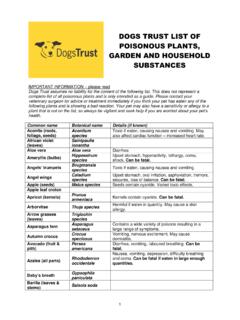Transcription of A Visual Guide: Rose Problems - Missouri Botanical Garden
1 Page 1 of 7 Visit us on the Web: Visual guide : rose ProblemsBlack spot of roseBlack spot is the most important disease of roses and one of the mostcommon diseases found everywhere roses are grown. The disease doesnot kill the plant outright, but over time, the loss of leaves can weaken theplant making it more susceptible to other stresses and to winter spots, one-tenth to one-half inch in diameter, develop first on upperleaf surfaces. Later, areas adjacent to the black spots turn yellow andleaves drop prematurely, usually beginning at the bottom of the plant andprogressing : Spot anthracnose (shot-hole disease) is not a major problemunless it is very hot (too hot for black spot).
2 Spots caused by black spot arefuzzy around the edges, then turn yellow and brown. Spots caused byanthracnose are smooth edged and the centers turn grey and drop out. Treatment is the same, but if a pesticide is used, it must be labeled forblack spot or anthracnose, whichever disease you are rosetteRose rosette disease, also known as witches'-broom of rose , is a virus orvirus-like disease, that is spread by a microscopic eriophyid mite. Themain symptom is a tightly grouped, proliferation of distorted, usuallybright red foliage (a witches'-broom).
3 Affected canes may be excessivelythorny, thicker than unaffected canes and slow to mature. The canes arealso soft, as are the prickles, and will break off with little : rose flower proliferation or bullhead (affects flowers only, notfoliage or stems, click here for picture), new growth (often bright red butwithout the proliferation of buds and prickles and with stems that arefirm, not soft)Page 2 of 7 rose mosaicSymptoms of this viral disease can include a general dwarfing of the plant,lack of proper chlorophyll production resulting in a mottled appearance onfoliage, yellowing and in some cases rings on leaves or fruit as well asnecrotic (dead) areas.
4 Often only a cosmetic problem. The disease can bespread by feeding insects or mites, or mechanically through hands : Herbicide damage, environmental Problems or other diseaseorganismsC. Calderon, USDA APHISPPQ, mildewPowdery mildew is caused by a fungus and is seen as a light gray orwhitish powder on the upper surface of leaves. It occurs following warmdays and cool nights with high relative humidity often seen in the springand fall. The disease is considered more unsightly than : If powdery mildew appears on only one or two plants , cut off theinfected parts and destroy.
5 Doing this between sprays can help control thespread and eliminate the need for an extra gall on wintercreeper euonymusCrown gallCrown gall is a bacterial disease that causes abnormal growths or galls onroots, twigs, and branches. The galls are often found at the base of a plantor just below the soil surface. The pathogen enters through wounds, eithernatural or caused by pruning, mechanical injury or chewing insects. Thebacterium stimulates the rapid proliferation of plant cells that results inthe galls, which are usually rounded, with a rough, irregular surface.
6 Asthe galls enlarge, they become woody and hard. The outer layer turnsbrown and corky. Roses that are not responding to fertilizer and generalgood care, may be affected by a gall under the soil : Sometimes the galls can have a smooth surface, making themdifficult to distinguish from callus growth at the base of the rose or thegraft love all members of the rose family and all parts of a rose , includingthe thorns. Look for missing flowers, leaves, and stems with ragged cuts. Ifhungry enough, they will ignore all repellents. Page 3 of 7 rose and pear slugsSawfly larvae chew the upper surface of rose leaves leaving behind thepapery, translucent lower leaf surface and the veins.
7 Heavy defoliationgives plants a brown scorched appearance. Look for sawfly larvae inmid-spring ( rose sawflies) or early summer (pear sawflies). Inspect bothupper and lower surfaces of the : Japanese beetle damage (late spring and summer)Adults feeding on an oakleaf hydrangea leafThe Dow Gardens Archive, Dow Gardens, beetlesJapanese beetles are 3/8" (8-11 mm) long and " (5-7 mm) wide, brilliantmetallic green insects with copper-brown wings. The larvae stage is foundin the soil where they feed on the tender roots of vegetables, lawn grasses,and other plants .
8 Beetles congregate in large numbers on rose flowers. Adults chew holes in flower buds, flower petals and on foliage between theveins, giving the leaves a lacelike, skeletonized are active for about six weeks in the summer. They overwinter as apartially grown grub in the soil below the frost line. The grubs resumefeeding on grass roots in the spring, and then pupate near the soil : rose and pear slugs (damage)W. Cranshaw, CSU, curculiosAdults are snout-nosed beetles (curculios) that feed on flower buds,usually yellow or white cultivars. Females deposit eggs inside unopened oropened flower buds.
9 Opened flowers will be riddled with ragged holes orthe buds will : rose chafer beetleLeaf-cutter beesThe most characteristic symptom of leaf cutter bees are the half-moonshaped holes they make on the edges of leaves as they remove disks of leaftissue to take back to their nest cells. They are one of the most importantnative pollinators and damage is only cosmetic. No treatment 4 of 7 Damage on Brugmansia leaf Spider mitesThe two-spotted spider mite is smaller than the head of a pin (top image). They tend to feed on the underside of the leaves, removing chlorophyll andcausing leaves to have a "bronzed" and/or stippled appearance (bottomimage).
10 Silken webbing may be present on underside of leaf. Heavilyinfested leaves turn brown, curl and drop : hopper and leafhopper damageNymph on wintercreeper euonymusCottony secretions and cast skins onmaple leafHoppers and leafhoppersHoppers can move with equal ease either forwards, backwards, orsideways like a crab. In addition, they can hop to escape danger or to moveto another host plant. Feeding damage from some species causes smallwhite spots (stippling) to appear on the upper leaf surface, usuallybeginning near the leaf midrib. Stippled areas can unite into larger whitishblotches on mature leaves.














